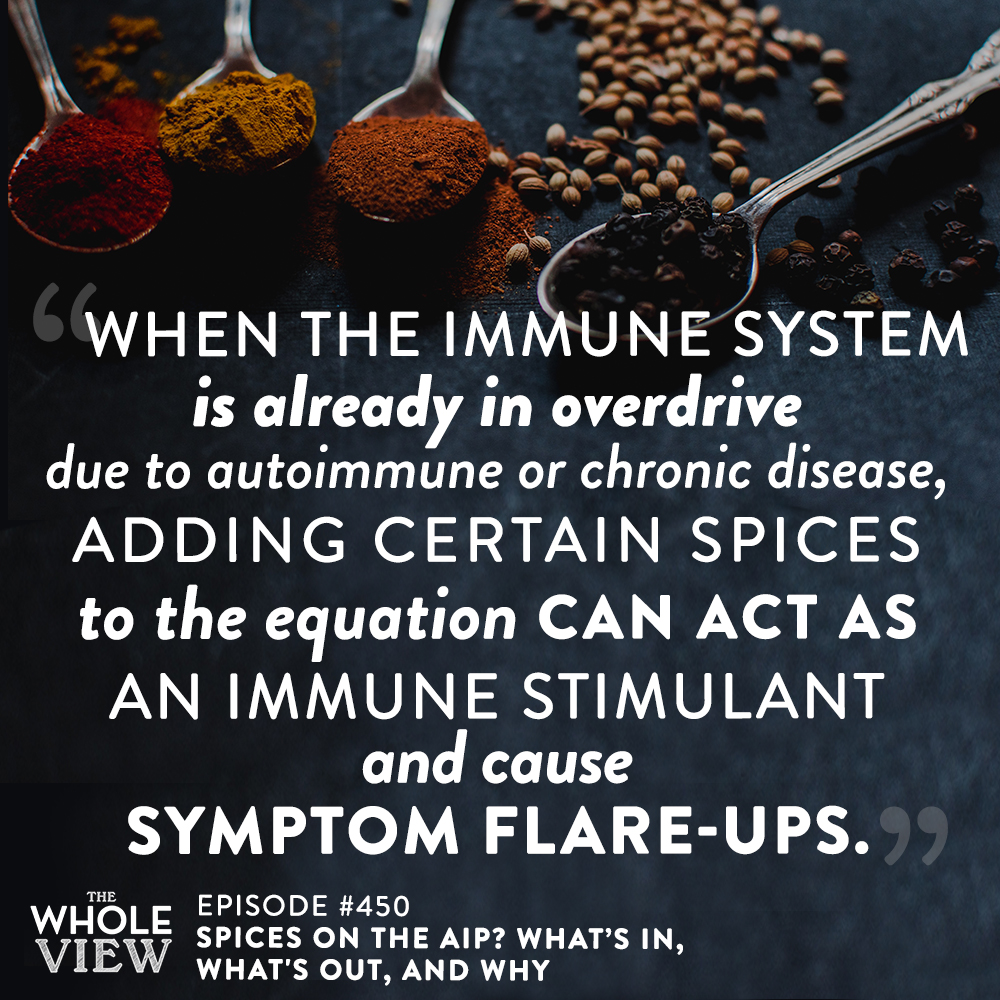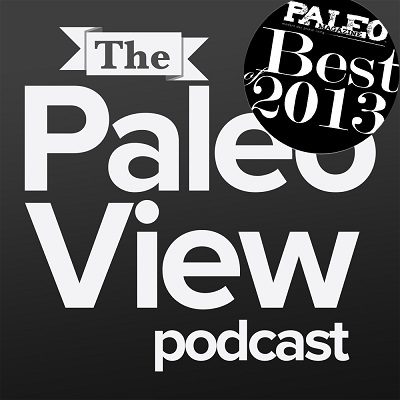
Welcome to episode 450 of The Whole View! This week, Stacy and Sarah do a deep dive into what herbs and spices on the AIP are awesome, considered early reintroductions, and which ones are best avoided until the very end.
If you enjoy the show, please review it on iTunes!
The Whole View, Episode 450: Spices on the AIP? What’s In, What’s Out, and Why.
Welcome back to episode 450! (0:28)
Stacy and Sarah both have sensitivities to nightshades due to inflammation-driven health issues.
Nightshades are common trigger foods and can be super problematic to autoimmune diseases and chronic illnesses as well.
This is because the immune system is already in overdrive. Adding an immune stimulant (such as nightshades) to the equation can cause symptom flare-ups.
The logic that goes into the autoimmune protocol requires a little bit of reasoning about how best to apply it to your day-to-day choices.
When writing her book on AIP, Sarah’s research really focused on how the immune system works and how it intersects with nutrients, lifestyle, hormones, etc.
Understanding how foods can be problematic for some people is never irrelevant. Even if you’re perfectly healthy, the science behind AIP can be applied to optimize diet and troubleshoot any future health issues.
In this episode, Stacy and Sarah plan to do a deep dive into what herbs and spices are awesome when on AIP, which are considered early reintroductions, and which ones are best avoided until the very end of the healing process.
For more references, please see:
Listener Question
This episode was inspired by this listener question from Jeff. (10:30)
Hello,
I’m a chef of 20 years and as most of us in the hospitality industry have experienced, things are not good. During my temporary retirement I’ve decided to help out a family who has started an AIP diet. I haven’t cooked specifically for a person who has said they are specifically AIP, but I have had plenty of experience with similar dietary needs. It will no doubt be a challenge, but it will be a fantastic learning experience and chance to change a persons experience while on their path to recovery.
In my journey I’m looking for ways to infuse the flavors which I like to use in ways that will be in line with the protocol. My inquiry has to do mainly with flavor infusion. Take for example a brine for pork. I use products like whole black peppercorn, whole coriander seed, mustard seed, etc. to add layers of flavor to the brine. Is the main issue with these spices the pieces of the seeds? Are the extracted oils also off limits? My main concern is around spices. I would venture to believe that nightshade oils are the problem (i.e. dried chilies, capsicum, etc).
– Jeff
Stacy reflects on how much she enjoy’s Jeff looking at it from a chemistry perspective in the cooking.
Alternatively, people who find out they can’t eat raw tomatoes might discover they can have cooked ones as they reintroduce foods back into their diet.
It’s very bioindivideal, meaning Stacy and Sarah can’t answer what foods will affect you and why. AIP is a way to isolate triggers for you personally to optimize your health.
Overall Philosophy Spices on the AIP
Sarah believes the most helpful place to start is taking a step back and looking at herbs and spices in general. (13:30)
The autoimmune protocol first tries to flood the body with nutrients- both essential and nonessential. Sarah references this show for more information on nutrient toxicity.
Another thing AIP tries to do is remove inflammatory properties from the diet. Herbs are derived from the leaves of fragrant plants and sometimes flowers.
They are safe to use whole, fresh or dried. It’s actually very beneficial to include them since the same phytonutrients that provide the flavor tend to be awesome antioxidants and anti-inflammatory.
Other properties they often have are anti-cancer, liver protective, neuroprotective, and more. See our Essential Oil show for more on extracts, though.
These can be more complex and don’t get an automatic pass. TPV Podcast, Episode 272: What’s the Deal with Essential Oils?
Spices often derive from non-reproductive plant parts like barks, roots, styles, and arils, but it’s not always the case.
Herbs don’t generally need to be ground before using in a recipe, whereas spices often need to be ground before using.
Why Spices on the AIP Are Eliminated
They are eliminated on AIP if they derive from seeds, berries, fruit, or the nightshade family. (21:20)
This is due to their unusually high food allergy and intolerance rates.
Seed spices should be avoided at first, even though many seed-based spices haven’t been specifically studied.
Spices that derive from berries and fruits of plants typically contain more seed than fruit. You are still consuming the ground seed.
Depending on your individual autoimmune challenges, some people tolerate the very small doses of seed-based spices used in cooking. This happens during Phase 1 Reintroductions.
As a result, seeds are often early reintroductions because they aren’t something that necessarily will show up on an allergy test.
However, something can cause inflammation or stomach issues without being an actual allergy. In that case, passing a test doesn’t mean you’re in the clear to eat it without complications.
Proteins that are unique to seeds as a reproductive part of the plant cause complications.
Also, the nightshade family causes problems for most people with autoimmune disease.
Nightshades are restricted on the Autoimmune Protocol due to high glycoalkaloid content and agglutinin content. They increase gut permeability and act as an adjuvant, exaggerating immune responses.
Spices from the nightshade family (mainly peppers) also contain capsaicin (one of the chemicals that give them heat), a mucus membrane and gut irritant.
Safe Herbs and Spices on the AIP
There are plenty of safe spices to have while on the AIP. (29:35)
However, extracts are not an automatic pass because you’re not necessarily getting everything from a plant. Some compounds might be concentrated and or skewed into being unbalanced.
When Sarah talks about “safe spices” she’s talking about the whole leaf, flower, root, or bark:
- Balm (lemon balm): Leaf of Melissa officinalis L.
- Basil Leaves (Sweet): Leaf of Ocimum basilicum
- Bay Leaves (Laurel): Leaf of Laurus nobilis
- Chamomile: Flower of Anthemisnobilis L. or Matricaria chamomilla L.
- Chervil : Leaf of Anthriscus cerefolium
- Chives: Leaf of Allium schoenoprasum
- Cilantro (Coriander): Leaf of Coriandrum sativum
- Cinnamon/Cassia: Bark of Cinnamomum spp.
- Cloves: Bud of Syzygium aromaticum
- Dill Weed: Leaf of Anethum graveolens/Anethum sowa
- Garlic: Bulb of Allium sativum
- Ginger: Root of Zingiber officinale
- Horseradish: Root of Armoracialapathfolia Gilib. *(Read ingredients for horseradish sauce!)
- Lavender: Flower of Lavandula officinalis Chaix.
- Mace: Aril of Myristica fragrans
- Marjoram Leaves: Leaf of Majorana hortensis Moench
- Onion Powder: Bulb of Allium cepa
- Oregano Leaves: Leaf of Origanum vulgare/Lippia spp.
- Parsley: Leaf of Petroselinum crispum
- Peppermint: Leaf of Mentha piperita
- Rosemary: Leaf of Rosmarinusofficinalis
- Saffron: Stigma of Crocus sativus
- Sage: Leaf of Salvia officinalis/Salvia triloba
- Salt: Mineral – moderation is important!
- Savory Leaves: Leaf of Satureia montana/Satureia hortensis
- Spearmint: Leaf of Menthaspicata
- Tarragon: Leaf of Artemisia dracunculus
- Thyme: Leaf of Thymus vulgaris/Thymus serpyllum/Thymus satureioides
- Turmeric: Root of Curcuma longa
- Vanilla Bean*: Fruit of Vanilla planifolia/Vanilla tahitensis Moore
*Vanilla gets a pass because the seeds are so small that they are intact when you consume them, putting vanilla bean (which is not a legume) in the same category as berries.
Moreover, Vanilla and vanilla extract is also okay, provided it’s certified gluten-free (often grain alcohol is used).
If it’s not a nightshade and comes from bark, root, leaf, or flower, you’re good to go!
What to Avoid
There is also a list of spices to avoid altogether, and some you should reintroduce at different stages in the AIP. (59:03)
Early Reintroduction Spices (Berries & Fruit)
- Allspice: Berry of Pimenta officinalis
- Star Anise: Fruit of Illicium verum Hook
- Caraway: Fruit or Carum carvi Maton.
- Cardamom: Fruit of Elettariacardamomum
- Juniper: Berry of Juniperus communis
- Black Pepper: Berry of Piper nigrum
- White Pepper: Berry of Piper nigrum
- Green Peppercorns: Berry of Piper nigrum
- Pink Peppercorns: Berry of Schinus terebinthifolius
Early Reintroduction Spices (Seeds)
- Anise Seed: Seed of Pimpinella anisum
- Annatto Seed: Seed of Bixa orellana
- Black Caraway (Russian Caraway, Black Cumin): Seed of Nigella sativa
- Celery Seed: Seed of Apium graveolens
- Coriander Seed: Seed of Coriandrum sativum
- Cumin Seed: Seed of Cuminum cyminum
- Dill Seed: Seed of Anethum graveolens/Anethum sowa
- Fennel Seed: Seed of Foeniculum vulgare
- Fenugreek: Seed of Trigonellafoenum-graecum
- Mustard Seed: Seed of Brassica juncea/B. hirta/B. nigra
- Nutmeg: Seed of Myristica fragrans
- Poppy Seed: Seed of Papaver somniferum
- Sesame Seed: Seed of Sesamum indicum
Avoid (Nightshades)
- Capsicums: Seed of Capsicum spp.
- Cayenne: Fruit of Capsicum annuum
- Chili Pepper Flakes: Many Varieties, fruit of Capsicum genus
- Chili Powder: Blend of fruit of Capsicum genus
- Curry: A spice mixture typically containing coriander, cumin, fenugreek, and red pepper.
- Paprika: Fruit of Capsicum spp.
- Red Pepper: Fruit of Capsicum
Common Spice Blends To Watch Out For
In general, Sarah doesn’t recommend against using any spice blends because the ingredients list often doesn’t actually say everything in it.
Sarah has no idea where it became okay to say “spices” or “natural flavors” on the labels.
But, here are some common spice blends you might have in your kitchen with components to worry about:
- Curry Powder: Mixture typically containing coriander, cumin, fenugreek, and red pepper.
- Chinese 5-Spice: Contains Star Anise, Peppercorns, and Fennel Seed
- Garam Masala: Contains peppercorns, cumin seeds and cardamom pods
- Poultry Seasoning: Often contains pepper, nutmeg
- Steak Seasoning: Usually contains pepper, chili, cumin, and cayenne
What About Brines, Broths and Oils?
For brines, broths, and oils, it really comes down to why we’re eliminating this food. And is the thing we’re eliminating fat or water-soluble. (1:08:05)
Proteins are water-soluble, so yes, you can get this in broth or brine.
For seed and berry/fruit-based spices, the concern is common food intolerance.
However, you can use these in flavored oils because little to no protein is imparted.
Also, with nightshades, avoid brines, broths, and oils. Glycoalkaloids have a detergent structure and help water and oil mix.
Final Thoughts
When it comes to nightshades, Sarah has not met very many people who have gone all the way through AIP and have successfully reintroduced all nightshades. (1:11:35)
Stacy has met a lot of people who are in denial that nightshades are an issue for them.
She adds that she was at the stage where, like Sarah, she could have a little nightshade spice every so often.
Then she got Covid and is a long-hauler. That, mixed with the stress of a pandemic and virtual school, she’s been very strict with avoiding nightshades.
She doesn’t want to risk undoing all the work she’s done by consuming nightshades when her body isn’t operating optimally due to her current stress.
But just because nightshades might be an issue for you, that doesn’t mean you can never have them ever again.
If eating your mother’s curry is an act of self-love and comfort, go ahead and eat it if that’s what you want to do. Just know and prepare yourself for a possible flare-up.
If you want to hear what Stacy and Sarah really think about today’s show, be sure to join the family on Patreon for some bonus behind the scenes content.
Thanks so much for listening, and we’ll see you next week!





